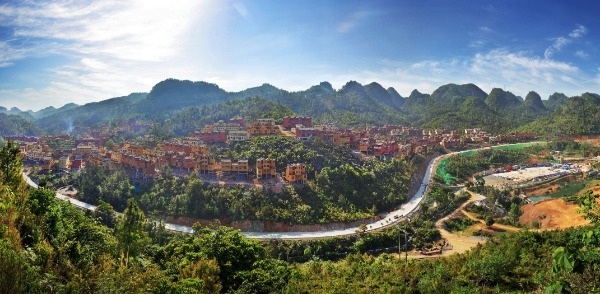Majority of impoverished Baiku Yao people bid farewell to poverty in Nandan
 |
|
The resettling residential districts of Baiku Yao people in Nandan. [Photo provided to China Daily] |
Located in the northwestern part of Guangxi, Nandan county is noted for the Baiku Yao people, an ethnic minority known for their white-colored pants. The minority has kept its culture intact, and is dubbed as a "living fossil" of human civilization.
China has about 50,000 Baiku Yao people, and 42,000 of them reside in Nandan county. During the country's 13th Five-Year Plan period (2016-2020), more than 23,000 Baiku Yao people in Nandan were registered as poverty-stricken, accounting for nearly half of the county's poor population.
Many of the Baiku Yao people used to live in the hard-to-reach hamlets scattered in the bare rock mountains. The towering mountains blocked people and services from the outside, and kept the isolated mountain dwellers in a battle against poverty for generations.
Back in the mountain-locked villages, fewer roads accessing to the outside have made people have to travel on foot most of the time. The roads here were either paved with dirt or small stones, which made rides very bumpy and vehicles could barely get through. People used to live in wood or mud huts with simple, old household items. When it rained, the roofs leaked and wind blew through. The acute shortage of drinking water and soil was another challenge for the mountain inhabitants. They had to collect rainwater in water tanks for daily use. Facing limited arable land for crops because of barren soil, locals eked out a living by growing corns in the cracks of the rock mountains. As the rock mountains were not suitable for living, the local government decided to relocate the Baiku Yao people to help them shake off poverty.
In 2017, the county government started a resettlement project that involved a total of 1.37 billion yuan ($197 million) of investment to build three major resettling residential districts in the county to accommodate the ethnic people, with about 13,500 people moving there. More than 2,400 new houses were built with cultural features of the Baiku Yao people, with bronze drums and ox horns painted on the walls. The new houses have been equipped with gas, tap water, flushing toilets and a variety of furnishings. Kindergartens, primary and middle schools and hospitals have also been in place in these districts.
With paved roads, a motorcycle ride to the county seat takes only about 20 minutes. Most of those residing in the mountains moved into the county center, beginning a new phase of their lives.
While lifting people out of poverty was the first step, efforts should be made to ensure the relocated residents can settle down, have jobs, earn money and lead better lives. In the resettlement sites, poverty-alleviation workshops have been established and the related industries have also developed based on local conditions, promising a steady source of income for the relocated residents. Local authorities have also stepped up tourism industry.
For instance, the three relocation districts have become tourist attractions featuring ethnic culture. Meanwhile, locals are encouraged to do ethnic performances for tourists and run homestays. Wearing their distinctive white pants, the Baiku Yao people are always seen welcoming tourists from afar by firing guns in the air, playing drums and whipping tops. So far, most of the impoverished Baiku Yao people in the county have bid farewell to poverty.
Copyright © Hechi Municipal People's Government. All rights reserved.
Presented by China Daily.
京ICP备13028878号-6






